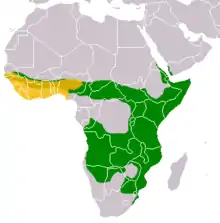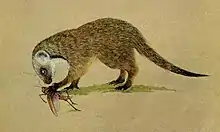Mungos
Mungos is a mongoose genus that was proposed by Étienne Geoffroy Saint-Hilaire and Frédéric Cuvier in 1795.[1]
| Mungos | |
|---|---|
 | |
| Banded mongoose, Mungos mungo | |
| Scientific classification | |
| Kingdom: | Animalia |
| Phylum: | Chordata |
| Class: | Mammalia |
| Order: | Carnivora |
| Suborder: | Feliformia |
| Family: | Herpestidae |
| Subfamily: | Mungotinae |
| Genus: | Mungos E. Geoffroy Saint-Hilaire & F. Cuvier, 1795 |
| Species | |
 | |
range of M. mungo range of M. gambianus | |
The genus contains the following species:[2]
| Image | Name | Distribution |
|---|---|---|
.jpg.webp) | Banded mongoose, M. mungo (Gmelin, 1788)[3] |  |
 | Gambian mongoose, M. gambianus (Ogilby, 1835)[4] |  |
References
- Geoffroy, E. & Cuvier, F. (1795). "Mémoire sur une nouvelle division des Mammifères, et sur Ies principes qui doivent servir de base dans cette sorte de travail, lu à la société d'Histoire naturelle, le premier floréal de l'an troisième". In Millin; Noel & Warens (eds.). Magasin Encyclopédique : ou journal des sciences, des lettres et des arts. Tome second. Paris: I'lmprimerie du Magazin Encyclopédique. pp. 164–189.
- Wilson, D.E.; Reeder, D.M., eds. (2005). "Genus Mungos". Mammal Species of the World: A Taxonomic and Geographic Reference (3rd ed.). Johns Hopkins University Press. ISBN 978-0-8018-8221-0. OCLC 62265494.
- Gmelin, J. F. (1788). "Viverra mungo". Caroli a Linné, Systema naturae per regna tria naturae, secundum classes, ordines, genera, species, cum characteribus, differentiis, synonymis, locis. I (13th aucta, reformata ed.). Lipsiae: Georg Emanuel Beer. p. 84–85.
- Ogilby, W. (1835). "Descriptions of Mammalia and Birds from the Gambia". Proceedings of the Zoological Society of London. Part III: 97–105.
This article is issued from Wikipedia. The text is licensed under Creative Commons - Attribution - Sharealike. Additional terms may apply for the media files.